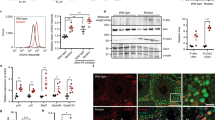Abstract
Previous work had shown a large accumulation (up to 50% of mtDNA) of a noninherited T414G transversion at a critical control site for mtDNA replication in skin fibroblasts from the majority of human subjects above 65 years old, and its absence in younger individuals. In the present studies, long-term in vitro culture of several fibroblasts populations carrying the heteroplasmic T414G mutation revealed an outgrowth of the mutant cells by wild-type cells. This observation supported the previous conclusion that the mutation accumulation is an in vivo phenomenon, while, at the same time, indicating intrinsic physiological differences between mutant and wild-type cells. Furthermore, subcloning experiments revealed a striking mosaic distribution of the mutation in the original fibroblasts populations, as shown by its presence, in heteroplasmic or homoplasmic form, in a fraction (18–32%) of the fibroblasts, and its absence in the others. In other investigations, transfer of mitochondria from mutation-carrying fibroblasts into mtDNA-less 143B.TK−ρ0 206 cells revealed the persistence of the mosaic distribution of the mutation, however, with a near-complete shift to homoplasmy. The generality of the latter phenomenon would exclude a founder effect by one or few mitochondria in the transformation experiments, and would rather point to the important role of the nuclear background in the in vitro behavior of the T414G mutation. The stability of the homoplasmic mutation in ρ0 cell transformants provides a powerful tool for analyzing its biochemical effects.
Similar content being viewed by others
LITERATURE CITED
Michikawa, Y., Mazzucchelli, F., Bresolin, N., Scarlato, G., and Attardi, G. (1999). Science 286:774–779.
Wang, Y., Michikawa, Y., Mallidis, C., Bai, Y., Woodhouse, L., Miller, C.A., Askanas, V., King Engel, W., Bhasin, S., and Attardi, G. (2001). Proc. Natl. Acad. Sci. U.S.A. 98:4022–4027.
Pulkes, T., Siddiqui, A., Morgan-Hughes, J.A., and Hanna, M.G. (2000). Neurology 55:1210–1212.
Cristofalo, V.J., and Charpentier, R. (1991). J. Tissue Culture Meth. 6:117–121.
Hofhaus, G., and Attardi, G. (1995). Mol. Cell. Biol. 15:964–974.
Michikawa, Y., and Attardi, G. (2002). In Methods in Molecular Biology, vol. 197: Mitochondrial DNA: Methods and Protocols,W. C. Copeland (ed.), Humana Press, Clifton, NJ, pp. 75–92.
Laderman, K.A., Penny, J.R., Mazzuccheli, F., Bresolin, N., Scarlato, G., and Attardi, G. (1996). J. Biol. Chem. 271:15891–15897.
Falanga, V., and Kirsner, R.S. (1993). J. Cell. Physiol. 154:506–510.
Yoneda, M., Miyatake, T., and Attardi, G. (1994). Mol. Cell. Biol. 14:2699–2712.
Müller-Höcker, J. (1989). Am. J. Pathol. 134:1167–1173.
Müller-Höcker, J. (1990). J. Neurol. Sci. 100:14–21.
Müller-Höcker, J. (1992). Brain Pathol. 2:149–158.
Müller-Höcker, J., Seibel, P., Schneiderbanger, K., and Kadenbach, B. (1993). Virchow's Arch. Pathol. Anat. 422:7–15.
Wanagat, J., Cao, Z., Pathare, P., and Aiken, J.M. (2001). FASEB J. 15:322–332.
Khrapko, K., Bodyak, N., Thilly, W.G., van Orsouw, N.J., Zhang, X., Coller, H.A., Perls, T.T., Upton, M., Vijg, J., and Wei, J.Y. (1999). Nucl. Acids Res. 27:2434–2441.
Reuven, N.B., Tomer, G., and Livneh, Z. (1998). Mol. Cell 2:191.
Gibbs, P.E.M., McGregor, W.G., Maher, V.M., Nisson, P., and Lawrence, C.W. (1998). Proc. Natl. Acad Sci. U.S.A. 95:6876–6880.
Chinnery, P.F., and Samuels, D.C. (1999). Am. J. Hum. Genet. 64:1158–1165.
Elson, J.L., Samuels, D.C., Turnbull, D.M., and Chinnery, P.F. (2001). Am. J. Hum. Genet. 68:802–806.
Coller, H.A., Khrapko, K., Bodyak, N.D., Nekhaeva, E., Herrero-Jimenez, P., and Thilly, W.G. (2001). Nat. Genet. 28:147–150.
Flory, P.J., Jr., and Vinograd, J. (1973). J. Mol. Biol. 74:81–94.
Author information
Authors and Affiliations
Rights and permissions
About this article
Cite this article
Michikawa, Y., Laderman, K., Richter, K. et al. Brief Communication: Role of Nuclear Background and in vivo Environment in Variable Segregation Behavior of the Aging-Dependent T414G Mutation at Critical Control Site for Human Fibroblast mtDNA Replication. Somat Cell Mol Genet 25, 333–342 (1999). https://doi.org/10.1023/A:1019972500785
Issue Date:
DOI: https://doi.org/10.1023/A:1019972500785




